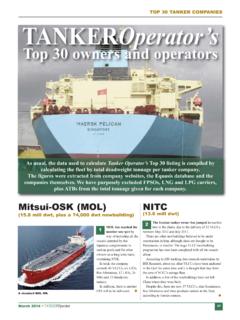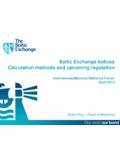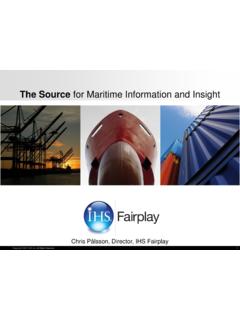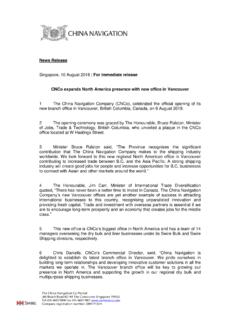Transcription of BANCOSTA Weekly Market Report
1 Banchero costa Weekly Market Report Week 40/2018 (1 October 5 October) Comment: Refineries plans for IMO 2020 index comment page 2 chartering dry cargo 3 tankers 6 containers 8 sale & purchase newbuildings / finance 9 secondhand / demolition 10 commodities news 11 prices 13 banchero costa network chartering - sale&purchase - ship finance - insurance - agency - research - and Follow us on: comment banchero costa 2 Market Report - week 40/2018 Questions remain ahead of IMO 2020 In recent weeks, IMO 2020 has dominated headlines as the deadline draws ever closer, and the intentions of major shipowners become clearer on whether to install scrubbers or rely on low sulphur fuels come 2020. The scale of the issue is staggering, with the consumption of percent high sulphur fuel oils (HSFO) by the global shipping fleet estimated at million barrels per day (bpd) at present.
2 The decision has been and continues to be a difficult one to make for most companies, as they each come to their own conclusion for the multitude of questions that remain, even as the new rules come into force at the end of next year: Will refineries be able to produce enough low sulphur fuels, and what will happen to the production of HSFOs? What will the price spread between HSFO and low sulphur alternatives be like? Would scrubbers breakeven, and if so, when? If installing open loop scrubbers, will individual port regulations differ in how scrubber effluent is dealt with? At least for refinery plans, a recent Reuters survey appears to shed some light, although the sufficiency and speed of changes in global refinery capacity remains a question. Discount of HSFO to low sulphur fuels subject to change as refiners expected to cut HSFO output 60 percent of the 33 refineries contacted by Reuters in a global survey still intend to produce HSFO come 2020, especially as demand for the oil from power generation and general users are expected to grow.
3 However, refineries intend to cut such production as they expect scrubber uptake to remain fairly limited and the value of HSFO to drop. While there has been an increasing number of news reports detailing scrubber uptake, ExxonMobil still forecasts more than 95 percent of the shipping industry without scrubbers. Thus, contrary to assumptions of an oversupply of HSFO come 2020, the scale of this glut might be less than originally anticipated as refineries take active steps to reduce HSFO production. The discount of HSFO to other low sulphur alternatives is thus subject to change depending on how the demand-supply dynamics play out, which could introduce much uncertainty into the payback period for shipowners who choose to install scrubbers. Some refineries are upgrading to produce more low sulphur fuels, but will this be enough? In order to reduce HSFO production, just over half of the refiners surveyed plan to upgrade their plants to further process fuel oil to produce more volumes of higher value products such as gasoline and diesel.
4 This tallies with news of an expected pick up of refinery upgrading through 2H 2018 and early 2019 in Europe and the former Soviet Union (FSU), which may impact crude demand and oil products supply in the short term. In India, upgrading works have also been underway. 3 state-run Indian energy firms Indian Oil Corp, Bharat Petroleum and Hindustan Petroleum announced in 2016 plans to spend $20 billion on refinery upgrading by 2022 to process fuel oil into gasoline and diesel. Private refiners Reliance Industries and Essar Oil have also invested heavily to build advanced refineries which produce gasoline at the expense of fuel oil. There are thus expectations that India, which has traditionally been a net exporter of fuel oil, may soon turn into a net importer of fuel oil. However, it remains uncertain if such upgrading works will provide sufficient processing capacity, given the lack of adaptive capex in recent years.
5 The time frame from engineering, approval, and installation of upgrades can take between 3-5 years, which means it could be too late for some refineries to upgrade in time for the new rules. Cost of upgrading means some refineries will employ other methods Two-thirds of the 16 refiners who responded to a question about how much investment they plan to pump into their plants to produce more ultra-low and low-sulphur fuel oil, said they plan to spend less than $100 million. 5 refiners are investing between $500 million and more than $1 billion in such projects. With such high costs involved, some refiners have said they will increase processing of sweet crudes in order to reduce the sulphur content in their products output. Crude supplies from North/ West Africa, Brazil, and parts of the North Sea are expected to be the most suitable, and thus likely to command a premium over sour crudes.
6 The crude trade will thus see major changes as sweet crudes become more popular, and also if low fuel oil margins force some refiners to reduce runs of their crude distillation units, or to switch configuration to produce other products in higher demand. Refineries plans for IMO 2020 Unit05-Oct28-SepW-o-WY-o-Y BCI TC ,02618, C8 Transatlantic r/vusd/day16,94419, C14 China-Brazil r/vusd/day18,15019, C10 Pacific r/vusd/day18,79516,208+ 1 Year TC Periodusd/day19,75019,750+ + cargo chartering banchero costa Despite Chinese holidays, activity in the Pacific basin was relevant and the Market quite volatile. During the first part of last week rates went from $ to low $9s/mt on the key route from West Australia to China, but eased down upon week closing in the high $8s/mt. The "catch up" of the rates in Pacific was not followed by similar movements on Tubarao-Qingdao trade which was capped by too many ballasters for October dates which allowed Vale to cover their cargoes at an average $20/mt for the first half of October dates.
7 For vessels with ETA Brazil during 2nd half of October a premium of around $ was noticed. The Atlantic Market was quiet with fronthaul rates in the mid/high $30,000s/d and mid/high teens for Transatlantic RV. Capesize Market Rates Panamax Market Rates Many expected a slow week with little excitement due to the long Chinese holidays. Indeed at the beginning of the week the Market was slow, but then both activity and rates started to pick up. South America continued to fix many ballasters from the East and ships open India and South-East Asia got good rates basis dop dely. A modern Kamsarmax was fixed at $16,800/d from Surabaya. In North Atlantic demand remained robust with many fresh cargoes; a Kamsarmax was fixed from the Continent at $17,000/d for a round voyage. The Pacific was also active with good volumes from Australia and Indonesia to India; rates increased a lot and charterers were forced to fix tonnage in other areas to compensate the lack of supply.
8 3 07,00014,00021,00028,00035,0005/10/175/2 /185/6/185/ 10/18 BCI TC and Capesize 1-YR Period (usd/day)1-YR TCBCI TC03,0006,0009,00012,00015,0005/10/175/ 2/185/6/185/10/18 BPI TC and Panamax 1-YR Period (usd/day)1-YR TCBPI TCmarket Report - week 40/2018 Unit05-Oct28-SepW-o-WY-o-Y BPI TC ,84913,595+ + BPI 82 TC ,65915,351+ P1 Transatlantic r/vusd/day14,69014,060+ + P2 Skaw-Gib Trip Eastusd/day21,95521,862+ + P3 Pacific r/vusd/day13,52513,306+ + 1 Yr TC Period Panamaxusd/day13,00012,500+ + 1 Yr TC Period Kamsarmaxusd/day15,00014,500+ + cargo chartering banchero costa The USG Market kept improving from early September both for handysize and Supramax. A short tonnage list compared to a long list of cargoes makes pretty easy to predict an improving Market moving forward. The ECSAm Market remains healthy with Tess58 fixing $20/20,500/d basis dely aps ECSAm to Med and Cont and Ultramax getting $21,500/d.
9 Trips to Spore/Japan range keep pushing the Market higher with Supramax fixing $16,000/d + 600,000 bb and Ultramax getting $17,000/d + 700,000 bb. handysize is not as good, but healthy rates are registered around $16,500/16,750/d for trip to Cont/Med and $18,500/18,750/d to F East. Supramax & handysize Market India S Africa The Cont Market registered good volumes of activity both on Handy and Supramax sizes with rates increasing a little so far. Fertilizers trades, again, dominated the handysize activity in Cont and a modern 34,000 dwt was fixed at $9,500/d basis dely N Cont for a TC trip via Baltic to USG. A 36,000 dwt was fixed and failed at $16,000/d basis dely Baltic to ECSAm. On period a 32,000 dwt got $10,000/d for a short period basis dely Cont and redely Atlantic. On Supramax the scrap trade increased around $1,000/d and a 57,000 dwt got $14,000/d, no fixtures were reported on fronthaul.
10 The Med and BSea Market was a mixed bag for Handies; a 37,000 dwt is on subs basis dely low Adriatic for a trip to BSea and back to Adriatic at $12,000/d with grains and a 33,000 dwt asking $16,000/d basis dely Cannakkale for a similar trip. On Supramax the Market remained relatively steady although the tonnage list is getting quite thin. A 55,000 dwt was fixed at $23,000/d basis dely Cannakkale for a trip to F East. During last week the MEG and Indian ocean Market maintained its positive trend for large units; a nice Ultramax was fixed for period at $15,000/d basis dely WC India and there are still quite a few orders out of MEG to F East, WC India and EC India, but tonnage on prompt dates is scarce. On handysize only a few ships were covered and the situation appears to be more balanced with rates increasing a little. Richards Bay coal exports were very active and with the help coming from ECSAm Ultramax were fixed in excess of $14,000/d + 400,000 bb for India destinations.








